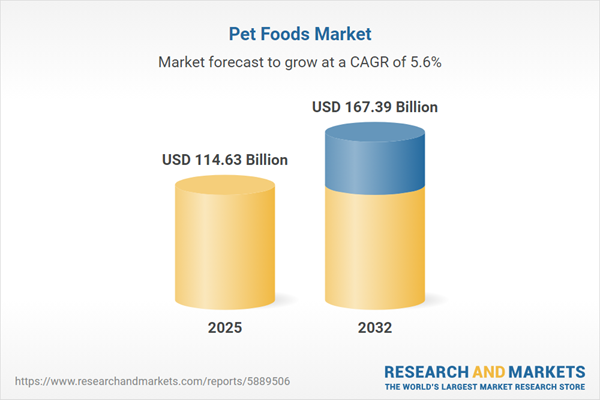Speak directly to the analyst to clarify any post sales queries you may have.
Senior executives in the pet foods market face a landscape defined by evolving consumer demands, intensified innovation cycles, and dynamic regulatory landscapes. Actionable market intelligence is vital for leaders aiming to drive growth, optimize operational decisions, and secure strategic positions in this complex sector.
Market Snapshot: Pet Foods Market Growth and Outlook
The global pet foods market is currently valued at USD 108.57 billion in 2024, with steady growth forecast to reach USD 114.63 billion in 2025 and USD 167.39 billion by 2032. This expansion is propelled by rising consumer interest in premium pet nutrition, the prioritization of animal wellness, and a marked demand for transparency and ethical sourcing. Companies are advancing operational excellence through digital distribution and technologies, aiming to align offerings with shifting market trends and increased accountability. Innovations in manufacturing processes and research enable faster development of differentiated products, while regulatory shifts require companies to adjust their strategies swiftly.
Scope & Segmentation: Strategic Foundations for the Pet Foods Market
This executive report offers a comprehensive overview for senior leadership seeking to capitalize on sector growth, optimize strategic planning, and respond decisively to evolving industry trends. Segmentation clarifies the key drivers shaping market evolution and unlocks insights into value creation across core segments:
- Animal Types: Examines both cat and dog food, exploring breed-specific nutrition needs and the influence of pet owner profiles on purchase patterns.
- Product Types: Details dry, raw (including freeze-dried and frozen options), treat, and wet foods, providing insight into product innovation and segmentation strategies.
- Distribution Channels: Evaluates e-commerce, subscription models, specialty retail, supermarkets, veterinary networks, and traditional shops, with focus on digitalization’s role in expanding market accessibility and customer engagement.
- Price Tiers: Reviews economy, standard, and premium categories to support differentiated product positioning and targeted audience messaging.
- Life Stages: Analyzes formulas tailored to juvenile, adult, and senior pets, supporting lifecycle-based marketing and customer retention.
- Ingredient Sources: Covers conventional, grain-free, high-protein, and organic ingredients, with specific attention to ethical sourcing and sustainability in response to changing consumer priorities.
- Geographic Regions: Provides intelligence for the Americas, Europe, Middle East and Africa, and Asia-Pacific, shedding light on diverse regulatory environments and market-specific consumption behaviors.
- Companies Profiled: Offers competitive insights on industry leaders, including Mars Petcare Inc., Nestlé Purina PetCare Company, The J.M. Smucker Company, Hill’s Pet Nutrition, Blue Buffalo, Spectrum Brands Holdings, Diamond Pet Foods, WellPet, Freshpet, and Central Garden & Pet Company.
Key Takeaways: Strategic Insights for Senior Decision-Makers
- Pursuing personalized nutrition solutions and transparent labeling enables brands to align with sophisticated, knowledge-driven consumer segments and sharpen market differentiation.
- Digital transformation across distribution and supply networks enhances responsiveness, enabling organizations to address shifting regulatory and consumer trends with greater agility.
- Sustainable sourcing practices and advances in eco-friendly packaging bolster brand credibility and optimize supply chain efficiency while addressing stakeholder expectations for long-term value.
- Implementation of emerging technologies, such as artificial intelligence, drives product customization and equips companies to better serve a wider range of customer needs.
- Adapting product ranges to reflect local preferences and pet life stages advances regional strategies and supports growth in specific markets.
- Collaboration with veterinary channels and technology partners strengthens customer loyalty and expands opportunities in high-value segments.
Tariff Impact: Responding to U.S. Trade Policy Changes
Recent changes in U.S. tariffs on pet food ingredients have introduced new challenges in procurement and cost stability. Many companies are enhancing domestic sourcing strategies, restructuring supplier relationships, and investing in advanced ingredient traceability systems—particularly for premium proteins and botanicals. These measures drive greater supply chain resilience and increase transparency across product lines.
Methodology & Data Sources
Research insights are derived from executive interviews and quantitative analysis across manufacturing, retail, and veterinary domains. Every finding undergoes a rigorous peer-review process, ensuring reliability and practical value for strategic planning and execution.
Why This Report Matters for Senior Executives
- Delivers precise, segment-specific market intelligence to enhance strategic decision-making, risk management, and growth planning in the pet foods market.
- Equips organizations to proactively address regulatory change, supply chain complexity, and evolving consumer expectations, increasing resilience and consistency in operations.
- Aligns leaders’ investment priorities and operational focus with the latest trends and innovations shaping the industry’s competitive landscape.
Conclusion
Senior executives leveraging timely market intelligence, agile response, and innovation can sharpen competitive positioning and navigate the evolving challenges and opportunities of the pet foods sector.
Additional Product Information:
- Purchase of this report includes 1 year online access with quarterly updates.
- This report can be updated on request. Please contact our Customer Experience team using the Ask a Question widget on our website.
Table of Contents
3. Executive Summary
4. Market Overview
7. Cumulative Impact of Artificial Intelligence 2025
Companies Mentioned
The companies profiled in this Pet Foods market report include:- Mars Petcare Inc.
- Nestlé Purina PetCare Company
- The J. M. Smucker Company
- Hill’s Pet Nutrition, Inc.
- Blue Buffalo Pet Products, Inc.
- Spectrum Brands Holdings, Inc.
- Diamond Pet Foods, LLC
- WellPet, LLC
- Freshpet, Inc.
- Central Garden & Pet Company
Table Information
| Report Attribute | Details |
|---|---|
| No. of Pages | 191 |
| Published | October 2025 |
| Forecast Period | 2025 - 2032 |
| Estimated Market Value ( USD | $ 114.63 Billion |
| Forecasted Market Value ( USD | $ 167.39 Billion |
| Compound Annual Growth Rate | 5.5% |
| Regions Covered | Global |
| No. of Companies Mentioned | 11 |









